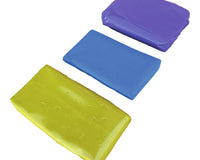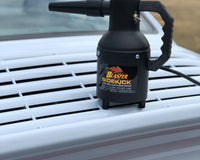Electric vehicles (EVs) have become increasingly popular across the UK, offering a cleaner and more sustainable alternative to traditional internal combustion engine cars. However, as the technology behind EVs differs significantly, so do their detailing and maintenance needs. From paint protection to safe cleaning practices around sensitive components, detailing an EV requires a slightly different approach than what most car enthusiasts may be used to.
EVs often feature flush door handles, intricate sensors, and charging ports that require special care during the detailing process. These design elements enhance aerodynamics and functionality but can also trap dirt and moisture if not cleaned correctly. Knowing how to approach these areas without causing damage is key to maintaining both aesthetics and performance.
Furthermore, many EV owners want to uphold the sleek, modern appearance that electric vehicles are known for. This includes paying close attention to trim, glass, and the high-gloss finishes often found on premium EV models. An informed detailing routine not only boosts visual appeal but also extends the life of the vehicle’s components, ensuring that it looks and performs like new for years to come.
Pre-Wash and Safe Washing Techniques for EVs
When it comes to washing an electric vehicle, using the right technique is more important than ever. High-pressure jets and excessive water exposure near charging ports, battery areas, or sensors can compromise performance if caution isn’t exercised. While most EVs are built with solid water resistance, it’s always wise to avoid direct pressure around these sensitive areas.
The pre-wash stage should start with a snow foam application. This helps to loosen and lift dirt from the surface without agitation, which is crucial for avoiding swirl marks. Allow the foam to dwell for several minutes before rinsing off with low-pressure water. This step dramatically reduces the chances of scratching the paint during contact washing.
During the main wash, use the two-bucket method — one for your shampoo solution and another for rinsing the mitt — along with a grit guard to trap debris. A pH-neutral car shampoo is essential, as it ensures your paintwork and protective coatings are not stripped away. Use a soft microfibre wash mitt and work in straight lines, not circles, to minimise swirl risks. Pay extra attention to crevices around the charging port and flush door handles, cleaning carefully with detailing brushes where needed.
Charging Port Maintenance and Cleaning
The charging port is one of the most critical components of an EV and should be handled with extra care during detailing. Although designed to withstand regular use and exposure to elements, it is still susceptible to grime buildup, especially from road salt, rainwater, and dust.
Begin by inspecting the charging port for any visible dirt or debris. Use a soft, clean detailing brush to gently remove loose dirt. If there is any stubborn grime, lightly dampen a microfibre towel with a safe, diluted all-purpose cleaner and wipe the area gently. Never spray water or cleaning products directly into the port, as this could compromise its integrity.

It’s advisable to dry the area thoroughly with a clean, dry towel to prevent any moisture ingress. For added protection, some EV owners apply a rubber-safe sealant around the gasket area of the port. This adds an extra barrier against water and dust intrusion, which can be especially useful during the wetter months in the UK.
Protecting the Paint and Finish of an EV
Most EVs come with advanced paintwork and unique finishes that can include satin, matte, or high-gloss coatings. These finishes require specific care to ensure they retain their appearance without becoming dulled or damaged over time. Regular polishing or waxing without understanding the paint type can do more harm than good.
A good first step is to understand your EV’s paint finish. If it’s a standard gloss, using a high-quality wax or ceramic sealant provides lasting protection and enhances shine. For matte or satin finishes, avoid traditional waxes and instead opt for dedicated matte paint sealants that don’t add gloss or alter the surface texture.
Ceramic coatings are particularly effective for EVs, especially in the UK’s variable weather. These coatings create a hydrophobic layer that resists dirt, bird droppings, and environmental fallout, making regular maintenance much easier. Professional application is recommended, but there are also high-quality DIY ceramic coatings available for confident enthusiasts.
Wheel and Tyre Detailing on Electric Vehicles
Electric vehicles are typically heavier than their petrol or diesel counterparts due to the battery packs. This added weight increases strain on the tyres and wheels, making their maintenance even more crucial. Well-maintained wheels not only contribute to better performance but also play a major role in the overall visual appeal of the vehicle.
Begin by spraying a non-acidic wheel cleaner onto the rims and letting it dwell for a few minutes. Use soft wheel brushes to agitate the solution gently, getting into the lug nuts, spokes, and brake callipers. Be mindful of EVs with regenerative braking systems, which may produce less brake dust, but still require regular cleaning to prevent corrosion.
Tyres should be cleaned with a stiff-bristled brush and a dedicated tyre cleaner. After cleaning, applying a water-based tyre dressing helps protect the rubber and enhances its appearance. Avoid silicone-based dressings that can sling onto the paint and degrade rubber over time, particularly in warmer conditions.
Interior Detailing for High-Tech EV Cabins
EV interiors are often minimalistic, tech-heavy, and packed with touchscreens and sensitive materials. This makes traditional interior cleaning techniques potentially damaging if not approached with the right tools and methods. Ensuring a clean interior while preserving these delicate elements requires precision.
Always use microfibre towels and screen-safe cleaners on infotainment displays and digital instrument clusters. Never spray cleaner directly on the screens; instead, apply it to the towel first. For touch-sensitive surfaces like piano black trim or fingerprint-prone buttons, use a damp cloth followed by a dry buff to eliminate smudges.
For the upholstery, whether leather, vegan leather, or fabric, select the appropriate cleaner based on the material. Steam cleaning can be effective for fabric seats, while leather-safe pH-balanced cleaners work best for leather or synthetic alternatives. Follow up with a UV-protectant to safeguard against sun damage, especially important given the large windscreens and panoramic roofs common in modern EVs.
Glass and Mirror Cleaning Specifics
EVs typically come equipped with advanced driver assistance systems (ADAS) that rely on cameras and sensors mounted behind the glass. Improper cleaning of these areas can hinder system performance or even damage sensitive components. Therefore, glass cleaning in EVs must be both thorough and gentle.
Use an ammonia-free automotive glass cleaner and apply it using a microfibre towel. Focus especially on the windscreen and side mirrors, ensuring clear visibility without streaks. Clean from top to bottom to avoid pushing dirt around, and always dry with a separate towel to prevent lint or smudges.
If your EV has a glass roof, don’t forget to include it in your routine. These areas can accumulate dust and water spots quickly. Regular cleaning followed by the application of a dedicated glass sealant will help water bead off and reduce the frequency of future cleaning sessions.
Undercarriage and Battery Protection
While EVs have fewer moving mechanical parts, their undercarriage still requires attention. In the UK, especially during winter, roads are often salted, which can lead to corrosion. Although battery packs are typically sealed and protected, the rest of the underbody can still be vulnerable.
Using a low-pressure rinse to flush out road grime and salt from the undercarriage is a safe and effective practice. Do not use pressure washers directly near the battery housing or cable points. A purpose-built undercarriage cleaner can help reach tricky areas without the risk of causing damage.
Applying an undercarriage protectant spray safe for EVs can add an extra layer of defence against corrosion. Make sure to reapply as recommended, especially if you live in coastal or high-salt areas.
Long-Term Protection and Maintenance
Maintaining an electric vehicle’s appearance goes beyond simple washes and polishing. Implementing long-term protection strategies ensures your EV looks as good years from now as it did on the day you took delivery. A regular detailing schedule, ideally every two weeks, combined with seasonal deep cleans, is a good place to start.
Additionally, consider storing your EV in a garage or under a high-quality car cover when not in use. UV rays, bird droppings, tree sap, and acid rain can all degrade the finish over time. A covered environment protects against these contaminants and helps maintain temperature stability around the vehicle.
For those interested in professional-grade protection, options like full-body PPF (paint protection film) or annual ceramic coating refreshers are highly effective. They require an upfront investment but pay off in reduced maintenance time and improved resale value.
Conclusion
Detailing your EV doesn’t just preserve its looks — it protects your investment and maintains performance integrity. With electric vehicles bringing new materials and technologies into the automotive space, detailers must evolve their practices to match. From safely cleaning the charging port to choosing the right products for tech-heavy interiors, each aspect demands careful consideration. By adopting a regular, informed detailing routine, you’ll ensure your EV remains in peak condition for years to come — looking sharp, running clean, and continuing to turn heads on the road.




